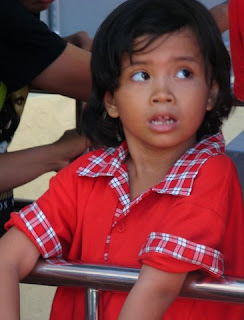June 2008: My team's flight landed in Jakarta. We were warned how different it would be from Malaysia and Singapore. We were cautioned about the religious conflict, about the poverty, about the resistence to Westerners. Security, safety, modesty, discretion.
I remember leaving the airport and being awed by the insane traffic and honking. I remember noticing all the trash; it was so dirty.
But I especially remember my first impressions being of the street children. Stuck in traffic, our vehicle sat near an intersection and I stared out the window into the eyes of children. They were barefoot. Their hair was dirty and tangled. The clothes hung off their shoulders. They weaved in and out of traffic, holding out a little bag, begging for money.
During the next days in Jakarta and Surabaya, and during my next visit in 2009, I gained many more impressions of the country. I fell in love with the people.
My last few posts have been a glimpse at a dream come true. Living with amazing Indonesian children and building relationships with them was beyond wonderful to me.
A friend of one of the orphanage staff members invited me to join her at a school held for street children. Immediately my first memories of Indonesia flashed through my mind: I saw that little girl barefoot, standing in the middle of traffic. I was both eager and apprehensive to visit the school. I knew the kids at the orphanage well; I knew their personalities, their strengths and weaknesses. I knew some about their families. I knew some of their dreams.
Somehow I couldn't associate that kind of interaction with what I had seen of street children. I remembered their emotionless faces, their subdued eyes.
And then we arrived, central Jakarta. We got out of the taxi in the middle of the road and crossed a busy highway. Train tracks, bridge, overpass, intersections, heaps of trash, and a nasty, rushing river.
In February 2009, this school began on a Sunday afternoon with several Indonesian teachers and about fifteen kids. A year later, as the small team of teachers walked down the strip between the railroad and the river, children began flocking to us from the street. Over eighty children gathered for a couple hours of "school."
They stared at me, wide-eyed at my fair skin. I smiled back and sat down beside a couple of them. "Nama saya Laura ... siapa nama kamu?"
Suddenly I realized that "Jakarta street children" are not a genre of people. They are individuals.
They have names. They have parents--whether they're in their life or not. They have siblings.
They have strengths and weaknesses. They have natural talents and abilities. They have great personalities.
They are beautiful, and every one of them is unique and perfect.
After the whole group sang a couple songs together, the children split into five groups, by age. Under the trees, five canvas mats were spread. Whiteboards were propped up against the trees. The children were given notebooks and pencils.
The next couple hours were spent on math problems, learning about nature and plants, and practicing English alaphabet and vocabulary words. The children were so, so excited to learn.
Around 30% of them, I was told, attend school sporadically.
Many of them lived under the nearby bridge. When the dam down the river was recently opened to release water, their families had to move because the river was so high. For the next few weeks, many of the children were sick and couldn't come to the Sunday street school. Many of the ones who did come had bad skin rashes or were sick from all the bacteria in the water.
After the children said good-bye, the team of teachers had a short meeting to review how many children attended each class, what they taught, what they observed, and to make plans for the future.
They have a big vision for impacting these children's lives and futures. They're recognizing what I had failed to see: the unique design of individual children, and the potential they have. Instead of being overwhelmed by the massive need, they actually pursued change. Instead of being frustrated by the limited time they have, they're making the most of every minute.
After the meeting, we gathered up the few school supplies and walked back to the nearby highway. The brown water gushed downriver beside us. We walked past heaps of garbage and tiny shacks ... homes. Across the highway, we saw several of the children who had just left school. They were holding their bags. They were begging.
I can't put my feelings at that moment into words. I couldn't comprehend the reality of their daily lives. They yelled, smiling and waving. The teachers waved back. They called them by name.
I was no longer seeing emotionless, hopeless, nameless faces, all in the category of "street children." I had touched them, sang with them, talked to them, taught them, stared into their stunning eyes, and laughed as they laughed. They were individuals, created in the image of God. They have value and potential. They were created for a purpose in life.




























































